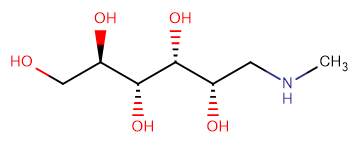
Meglumine
CAS No. 6284-40-8
Meglumine( 1-Deoxy-1-(methylamino)-D-glucitol | Iosulamide | N-Methyl-D-glucamine )
Catalog No. M15376 CAS No. 6284-40-8
Meglumine is an amino sugar derived from sorbitol.
Purity : >98% (HPLC)
 COA
COA
 Datasheet
Datasheet
 HNMR
HNMR
 HPLC
HPLC
 MSDS
MSDS
 Handing Instructions
Handing Instructions
| Size | Price / USD | Stock | Quantity |
| 500MG | 45 | In Stock |


|
| 1G | Get Quote | In Stock |


|
Biological Information
-
Product NameMeglumine
-
NoteResearch use only, not for human use.
-
Brief DescriptionMeglumine is an amino sugar derived from sorbitol.
-
DescriptionMeglumine is an amino sugar derived from sorbitol. It is often used as an excipient in pharmaceuticals and in conjunction with iodinated compounds in contrast media such as diatrizoate meglumine and iodipamide meglumine.
-
In VitroWestern Blot Analysis Cell Line:C2C12 mouse myoblasts Concentration:0, 10, 30, 100, 300 mM or 200 mM Incubation Time:60 min or 0, 10, 30, 60, 120 min Result:Increased the levels of SNARK protein in a dose-dependent manner after 60 min and reached a plateau at 30 minutes.
-
In VivoAnimal Model:Sprague-Dawley ratDosage:25 or 50 mM Administration:p.o., dissolve in water Result:Reduced the isoprostane levels in rats.Animal Model:K6/ODC transgenic mice Dosage:37.5 mM Administration:p.o., dissolve in water Result:Reduced the number of skin tumors and inhibited tumor growth.Animal Model:KK.Cg-Ay/J mice Dosage:18 mM Administration:p.o., in drinking water Result:Performed better in a glucose tolerance test.Decreased their average fasting levels of glucose and triglyceride levels in both the liver and blood serum.
-
Synonyms1-Deoxy-1-(methylamino)-D-glucitol | Iosulamide | N-Methyl-D-glucamine
-
PathwayOthers
-
TargetOther Targets
-
RecptorOthers
-
Research AreaOther Indications
-
Indication——
Chemical Information
-
CAS Number6284-40-8
-
Formula Weight195.21
-
Molecular FormulaC7H17NO5
-
Purity>98% (HPLC)
-
SolubilityWater: 39 mg/mL (199.78 mM); DMSO: 39 mg/mL (199.78 mM)
-
SMILESO[C@H]([C@H]([C@@H]([C@@H](CO)O)O)O)CNC
-
Chemical Name(2R,3R,4R,5S)-6-(methylamino)hexane-1,2,3,4,5-pentaol
Shipping & Storage Information
-
Storage(-20℃)
-
ShippingWith Ice Pack
-
Stability≥ 2 years
Reference
1.Navaei A, et al. Drug Dev Ind Pharm. 2014 Jun;40(6):701-10.
molnova catalog



related products
-
(2R)-3-Hydroxy-2-[4-...
The stems of Sambucus williamsii.
-
Pimecrolimus
Pimecrolimus, like all ascomycins, is an immunophilin ligand, which binds specifically to the cytosolic receptor, immunophilin macrophilin-12.
-
Gp100 (25-33), human...
Gp100 (25-33), human TFA is a 25-33 amino acid fragment of human melanoma antigen.Gp100 (25-33), human TFA is a 9-amino acid (AA) epitopes restricted by h-2db and recognized by T cells.



 Cart
Cart
 sales@molnova.com
sales@molnova.com


